Panacea Journal of Medical Sciences
Panacea Journal of Medical Sciences (PJMS) open access, peer-reviewed triannually journal publishing since 2011 and is published under auspices of the “NKP Salve Institute of Medical Sciences and Research Centre”. With the aim of faster and better dissemination of knowledge, we will be publishing the article ‘Ahead of Print’ immediately on acceptance. In addition, the journal would allow free access (Open Access) to its contents, which is likely to attract more readers and citations to articles published in PJMS.Manuscripts must be prepared in accordance with “Uniform requiremen...
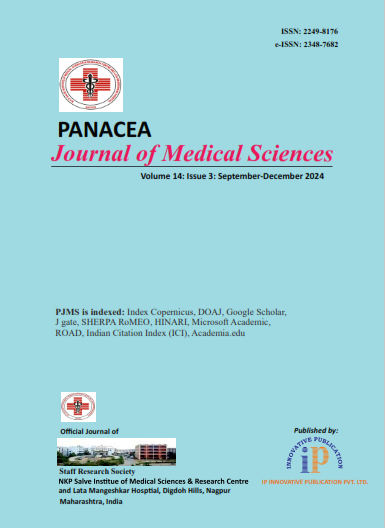
A comparative study of life events in depressive patients and schizophrenia
Introduction
In the recent decades, stress has become a term of popular parlance with respect to psychobiology. Stress denotes the aftereffects of failure of an organism or human to adapt appropriately to emotional or physical challenges, whether actual or imagined.[1] The relationship between stress and illness is not linear. It varies from person to person and depends on personality make up, genetic vulnerability, coping skills and social support.
Stress has become an unavoidable part of our daily lives. With the increase in needs of an individual or family and tight competition for essentials of living, stress has started to affect the emotions and reactions of an individual. Busy lifestyles, tight competition at work, financial commitments, marital problems, bereavement, chronic illnesses are some of the common causes of stress that leads to ill effects. We cannot evade from stress in our lives and stress at certain level is not always harmful. Consequences of stress depends on its type, intensity, duration and temporal association. [2]
Most of the effect of stress on mind and body are due to the increased activity of the sympathetic nervous system and increased secretions of adrenaline, cortisol, neurotransmitters, prostaglandins and some enzymes. The areas mainly affected by stress are brain and nerves, muscles, joints, cardiovascular system, stomach, skin and reproductive system. Stress response in controlled by the hypothalamus.[3]
For better understanding of stress and its consequences, it would be just to quantify the effects of stressful life events. A life event is a significant occurrence involving a relatively abrupt change that may produce serious long-lasting effects. [4] Stressful life events can result in a variety of mental and physical health problems. Perception of stress is a subjective phenomenon and hence, same life event can be stressful to some and not to others. An individual’s personality make-up and vulnerability influence his perception of stress and in turn determines his reaction to the same. [5]
Depressive disorders are characterized by persistent low mood, lack of interest in otherwise pleasurable activities, easy fatiguability, persistent sleep and appetite problems, lack of confidence, memory lapses etc. The universal prevalence of depression is around 3.8%.[6] While the genetic liability of depressive disorder is around 30-40%, there is increasing evidence that it is caused by interplay between neuronal circuitry and stressful life events in vulnerable individuals.[7] Decrease in gene expression of BDNF and the glucocorticoid receptor following stressors has been well documented.[8] There is a large body of evidence suggesting the pivotal role of life events before the onset of depressive episodes.[9], [10], [11], [12]
Schizophrenia is a major psychiatric illness which can affect the thought, cognition, perception and behavior of the affected individual. The universal prevalence of schizophrenia is around 0.32%.[13] The role of life events in the onset of schizophrenia is not as robust as in depressive disorders. Lukoff and Ventura, in a study reported in 1984, observed that stressful life event clustered around 3-4 weeks prior to the onset of schizophrenic episode.[14] Several studies have linked stress to relapse in schizophrenia patients rather than the onset.[15], [16], [17]
For better conceptualization of stressful life events preceding psychiatric illnesses, one has to move from vague notion of stress to a concise and measurable description of the nature of life events with a degree of reliability and specificity. In this study, we aim to compare the presence and nature of life events preceding the onset of depressive disorders and schizophrenia, in a rural Indian setting.
Materials and Methods
This observational study was conducted in a tertiary medical college in rural south India. Institutional ethical clearance was obtained before the start of the study. A total of 92 participants, out of which 46 schizophrenia patients and 46 depressive disorder patients, fulfilling the inclusion criteria, attending psychiatry OPD during an 18-month period, were selected for the study. The patients and their family were explained about the nature of the study. Confidentiality about the identity and data gathered were assured. Written informed consent was taken before enrolling the participant into the study.
Inclusion criteria
Patients of age 18-60 years, who are diagnosed to have depressive disorders or schizophrenia according to ICD 10 DCR.
Patients who have had the onset of illness within last one year.
Exclusion criteria
Patients with co-morbid physical illness.
Patients with mental retardation.
Patients having substance use disorders or other Axis-1 disorders.
Patients with major cognitive deficits.
Study tools used
Semi-structured proforma to collect socio-demographic data.
Presumptive stressful life events scale (PSLES): Inventory of 51 items, each item having a weighted score.
Data collected was entered in Microsoft excel and analyzed using Epi-info. Descriptive statistics such as proportions, means and standard deviations were calculated. Z-test for difference between proportions and means were used wherever applicable.
Results
In this study, the majority of onset of schizophrenia was between 21-40 years and for depressive disorders, it was between 31-50 years as shown in [Figure 1]. There was no statistically significant difference between males and females in both the groups as shown in [Figure 2]. Majority of the subjects in both the groups were self-employed as shown in [Figure 4]. Majority of patients in both groups were married and living with their spouse and children as shown in [Figure 5], [Figure 6].
Life event score for depressive disorders was significantly higher than schizophrenia group as shown in [Table 3]. The mean time lag between the life event and onset of depression was around 2.7 months while for schizophrenia it was around 5.54 months, as shown in [Table 2]. The most commonly reported life events were family conflict, large loans, marital conflict, son or daughter leaving home and illness in family members, as shown in [Table 1]. All of these life events were significantly higher in depressive disorders.
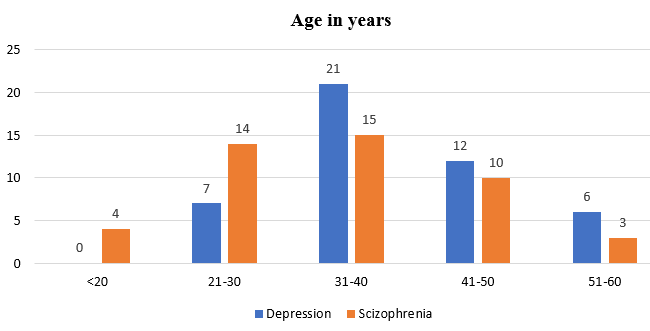
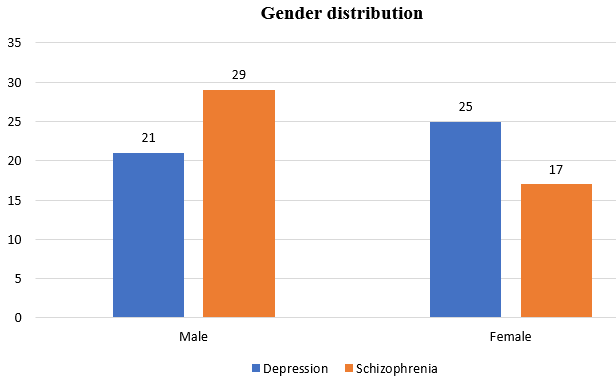
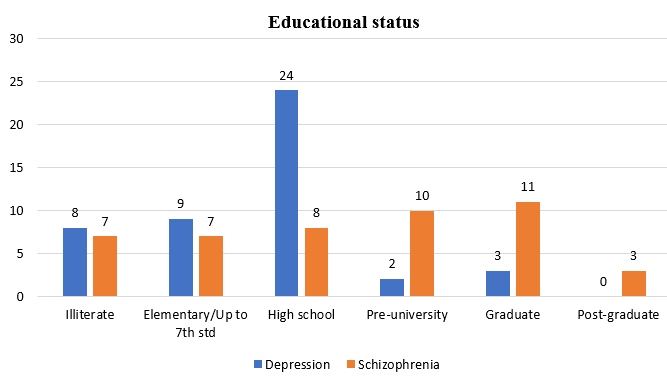
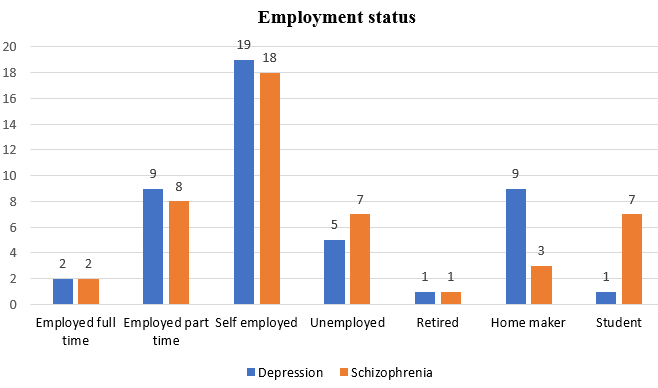
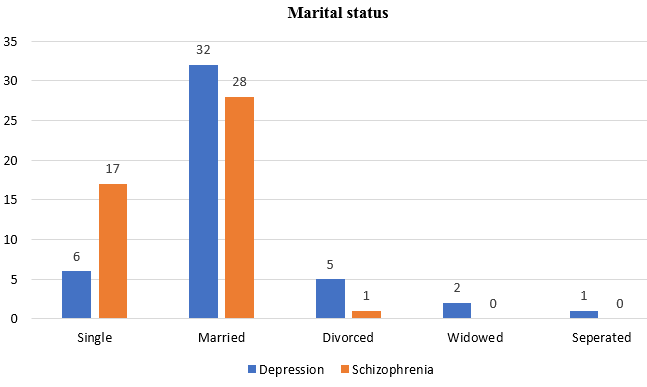
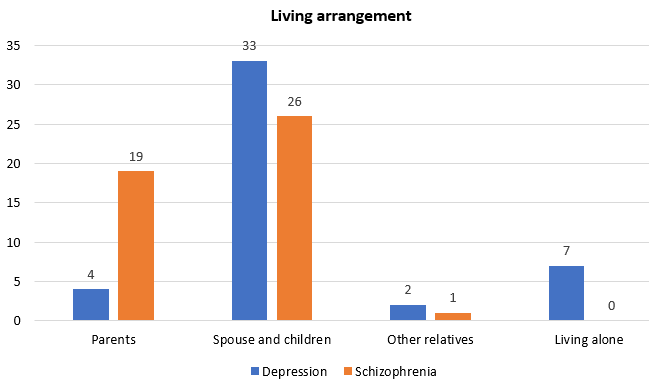
|
S.No |
Life event with mean stress score |
Depression |
Percentage |
Schizophrenia |
Percentage |
P value |
|
1. |
Going on pleasure trip or pilgrimage (20) |
4 |
8.70 |
0 |
0 |
- |
|
2. |
Wife begins or stops work (25) |
0 |
0 |
4 |
8.70 |
- |
|
3. |
Change in eating habits (27) |
1 |
2.17 |
2 |
4.35 |
0.57 |
|
4. |
Change in social activities (28) |
4 |
8.70 |
3 |
6.52 |
0.78 |
|
5. |
Reduction in number of family functions (29) |
6 |
13.04 |
0 |
0 |
- |
|
6. |
Gain in new family member (30) |
2 |
4.35 |
1 |
2.17 |
0.55 |
|
7. |
Birth of daughter (30) |
2 |
4.35 |
1 |
2.17 |
0.55 |
|
8. |
Change in sleeping habits (33) |
4 |
8.70 |
4 |
8.70 |
1 |
|
9. |
Change in working condition or transfer (33) |
1 |
2.17 |
0 |
0 |
- |
|
10. |
Retirement (35) |
1 |
2.17 |
0 |
0 |
- |
|
11. |
Begin or end schooling (36) |
0 |
0 |
1 |
2.17 |
- |
|
12. |
Outstanding personal achievement (37) |
0 |
0 |
0 |
0 |
- |
|
13. |
Change or expansion of business (37) |
1 |
2.17 |
1 |
2.17 |
- |
|
14. |
Change in residence (39) |
1 |
2.17 |
2 |
4.35 |
- |
|
15. |
Unfulfilled commitments (40) |
4 |
8.70 |
2 |
4.35 |
0.39 |
|
16. |
Trouble with neighbour (40) |
2 |
4.35 |
2 |
4.35 |
1 |
|
17. |
Getting married or engaged (43) |
5 |
10.87 |
1 |
2.17 |
0.09 |
|
18. |
Appearing for examination or interview (43) |
1 |
2.17 |
0 |
0 |
- |
|
19. |
Failure in examination (43) |
0 |
0 |
1 |
2.17 |
- |
|
20. |
Death of a pet (44) |
0 |
0 |
0 |
0 |
- |
|
21. |
Major purchase or construction of house (46) |
4 |
8.7 |
2 |
4.35 |
0.39 |
|
22. |
Break up with friend (47) |
2 |
4.35 |
3 |
6.52 |
0.64 |
|
23. |
Family conflict (47) |
18 |
39.13 |
4 |
8.70 |
0.0001 |
|
24. |
Minor violation of law (48) |
0 |
0 |
1 |
2.17 |
- |
|
25. |
Marriage of daughter or dependent sister (49) |
6 |
13.04 |
1 |
2.17 |
0.04 |
|
26. |
Large loan (49) |
14 |
30.43 |
2 |
4.35 |
0.0001 |
|
27. |
Lack of son (51) |
3 |
6.52 |
0 |
0 |
- |
|
28. |
Self or family member unemployed (51) |
3 |
6.52 |
0 |
0 |
- |
|
29. |
Sexual problems (51) |
1 |
2.17 |
0 |
0 |
- |
|
30. |
Conflict over dowry (self or spouse) (51) |
3 |
6.52 |
0 |
0 |
- |
|
31. |
Pregnancy of wife (wanted or unwanted) (52) |
0 |
0 |
0 |
0 |
- |
|
32. |
Prophrecy of astrologer or palmist etc. (52) |
2 |
4.35 |
2 |
4.35 |
1 |
|
33. |
Trouble at work with colleagues, superiors or subordinates (52) |
1 |
2.17 |
3 |
6.52 |
0.28 |
|
34. |
Illness of family member (52) |
7 |
15.22 |
1 |
2.17 |
0.02 |
|
35. |
Financial loss or problems (54) |
6 |
13.04 |
3 |
6.52 |
0.29 |
|
36. |
Son or daughter leaving home (55) |
9 |
19.57 |
1 |
2.17 |
0.007 |
|
37. |
Major personal illness or injury (56) |
5 |
10.87 |
2 |
4.35 |
0.23 |
|
38. |
Broken engagement or love affair (57) |
6 |
13.04 |
2 |
4.35 |
0.14 |
|
39. |
Conflict with in-laws (other than over dowry) (57) |
3 |
6.52 |
1 |
2.17 |
0.007 |
|
40. |
Excessive alcohol or drug abuse by family member (58) |
3 |
6.52 |
0 |
0 |
- |
|
41. |
Robbery or theft (59) |
1 |
2.17 |
3 |
6.52 |
0.29 |
|
42. |
Death of friend (60) |
0 |
0 |
1 |
2.17 |
- |
|
43. |
Property or crops damaged (61) |
2 |
4.35 |
1 |
2.17 |
- |
|
44. |
Marital conflict (61) |
10 |
21.74 |
3 |
6.52 |
0.03 |
|
45. |
Death of close family member (66) |
6 |
13.04 |
5 |
10.87 |
0.74 |
|
46. |
Lack of child (67) |
0 |
0 |
0 |
0 |
- |
|
47. |
Detention in jail of self or close family member (72) |
0 |
0 |
2 |
4.35 |
- |
|
48. |
Suspension or dismissal from job (76) |
0 |
0 |
0 |
0 |
- |
|
49. |
Marital seperation / divorce (77) |
4 |
8.70 |
0 |
0 |
- |
|
50. |
Extramarital relation of spouse (80) |
5 |
10.87 |
0 |
0 |
- |
|
51. |
Death of spouse (95) |
1 |
2.17 |
0 |
0 |
- |
|
From onset of life event/s to occurrence of disease |
Depression |
Schizophrenia |
P value |
|
Mean |
2.74 |
5.54 |
<0.001 |
|
Standard deviation |
1.29 |
1.70 |
|
Group |
Depression |
Schizophrenia |
P value |
|
Mean |
175.09 |
70.89 |
<0.001 |
|
Standard deviation |
112.72 |
57.50 |
Discussion
The age of onset of schizophrenia and depression in our study was in concordance in facts established in earlier researches. [3], [6], [13], [18], [19] Majority of the participants in this study were farmers, shepherds, daily wage workers or owners of small shops. This is a typical occupational pattern in rural south India. Majority of patients in both groups were married and living with their spouses and children. This can be explained by the dependent culture in India, which strengthens the social support system.
In this study, the life event score for depression was much higher when compared with the schizophrenia group. This is in concordance with many of the earlier studies.[9], [10], [20], [21], [22] In schizophrenia, life events were related more to relapses rather than onset as shown in many studies.[23], [24] Research in the past has shown that life stress merely act as final impetus towards illness in a person strongly predisposed to schizophrenia because of an underlying diathesis.[23]
The time lag between the life event and onset of depression in our study was shown as 2.74 months and for schizophrenia, it was 5.54 months. This was in contrast in some of the earlier studies which showed not more than a one-month time lag between life event and onset/relapse of schizophrenic symptoms.[14], [25] This could be sometimes due to the lack of awareness of prodromal symptoms of schizophrenia among rural Indian population. In rural India, mentally ill people are usually taken for medical consultation only when they exhibit disruptive behaviors.
Although literature suggests that life events play an important role in precipitation and relapse of psychiatric disorders, this relationship is not straight forward. The relationship between stress and illness varies with preexisting vulnerability factors. The differences in social support system, skills, attitudes, beliefs, and personality characteristics renders some individuals relatively immune to stress induced illness and make others relatively susceptible. The protective factors against stress, in our country, include dependent family culture, and relatively low cost of living. Education from young ages should focus on stress management, healthy daily routine, emphasizing quality communication among family members, financial management, problem solving skills, decision making skills and improving coping skills. Importance of self-care should be ascertained in family and school. Future research may focus on other intervening variables in order to reduce the incidences of stress induced illnesses.
Limitations of the Study
Low sample size
Retrospective recall of life events
Strength of the Study
Homogeneous sample of patients in both groups.
PSLES typically fits the rural Indian population.
Source of Funding
None.
Conflict of Interest
None.
References
- B Mannapur, AS Dorle, LD Hiremath, CH Ghattargi, U Ramadurg, KR Kulkarni. A study of psychological stress in undergraduate medical students at S N Medical College, Bagalkot, Karnataka. J Clin Diagn Res 2010. [Google Scholar]
- H Selye, G Serban. Stress without Distress. Psychopathology of Human Adaptation 1976. [Google Scholar] [Crossref]
- Ssm Chan. Kaplan & Sadock’s Comprehensive Textbook of Psychiatry, 7th Edition. Hong Kong J Psychiatry 2001. [Google Scholar]
- RA Settersten, KU Mayer. The Measurement of Age, Age Structuring, and the Life Course. Annu Rev Sociol 1997. [Google Scholar]
- P Shejwal. Locus of control: A personality correlates in Life events stress. Psychol Stud 1986. [Google Scholar]
- . World Health Organization: WHO, World Health Organization: WHO. Depressive disorder (depression). 2023. [Google Scholar]
- W Styron. . Darkness Visible: A Memoir of Madness 1990. [Google Scholar]
- DM Silberman, GB Acosta, MAZ Zubilete. Long-term effects of early life stress exposure: Role of epigenetic mechanisms. Pharmacol Res 2016. [Google Scholar] [Crossref]
- ES Paykel, JK Myers, MN Dienelt, GL Klerman, JJ Lindenthal, MP Pepper. Life events and depression. A controlled study. Arch Gen Psychiatry 1969. [Google Scholar]
- V Rao, N Nammalvar. Life Changes and Depressive Disease. Indian J Psychiatry 1976. [Google Scholar]
- S Grover, A Dutt, A Avasthi. An overview of Indian research in depression. Indian J Psychiatry 2010. [Google Scholar]
- SM Monroe, KL Harkness, AD Simons, ME Thase. Life stress and the symptoms of major depression. J Nerv Ment Dis 2001. [Google Scholar]
- . World Health Organization: WHO. Schizophrenia [Internet]. 2022. [Google Scholar]
- D Lukoff, KS Snyder, J Ventura, KH Nuechterlein. Life events, familial stress, and coping in the developmental course of schizophrenia. Schizophrenia Bulletin 1984. [Google Scholar]
- GW Brown, JL Birley. Crises and life changes and the onset of schizophrenia. J Health Soc Behav 1968. [Google Scholar]
- J Ventura, KH Nuechterlein, D Lukoff, JP Hardesty. A prospective study of stressful life events and schizophrenic relapse. J Abnorm Psychol 1989. [Google Scholar]
- MB Das, PL Kulhara, SK Verma. Life events preceding relapse of schizophrenia. Int J Soc Psychiatry 1997. [Google Scholar]
- EJ Bromet, J Schwartz, S Fennig, L Geller, L Jandorf, B Kovasznay. The Epidemiology of Psychosis: The Suffolk County Mental Health Project. Schizophr Bull 1992. [Google Scholar]
- JC Beck, K Worthen. Precipitating stress, crisis theory, and hospitalization in schizophrenia and depression. Arch Gen Psychiatry 1972. [Google Scholar]
- JG Rabkin. Stressful life events and schizophrenia: a review of the research literature. Br J Psychiatry 1980. [Google Scholar]
- R Norman, A Malla. Stressful life events and schizophrenia. I: A review of the research. Br J Psychiatry 1993. [Google Scholar]
- RK Chung, P Langeluddecke, C Tennant. Threatening life events in the onset of schizophrenia, schizophreniform psychosis and hypomania. Br J Psychiatry 1986. [Google Scholar] [Crossref]
- JL Birley, GW Brown. Crises and life changes preceding the onset or relapse of acute schizophrenia: clinical aspects. Br J Psychiatry 1970. [Google Scholar]
- J Ventura, KH Nuechterlein, D Lukoff, JP Hardesty. A prospective study of stressful life events and schizophrenic relapse. J Abnorm Psychol 1989. [Google Scholar]
- GE Vaillant. Prospective prediction of schizophrenic remission. Arch Gen Psychiatry 1964. [Google Scholar] [Crossref]
Article Metrics
- Visibility 6 Views
- Downloads 3 Views
- DOI 10.18231/j.pjms.2024.149
-
CrossMark
- Citation
- Received Date December 08, 2023
- Accepted Date May 29, 2024
- Publication Date December 21, 2024